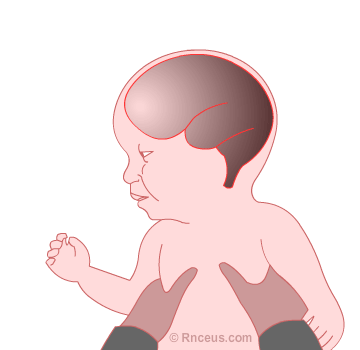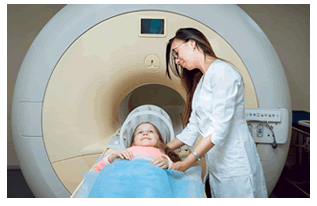Direct impact, meaning a child’s head was hit with an object or slammed against a solid surface, can cause skull fractures, cerebral edema and potentially retinal hemorrhages.
 Indirect impact can cause serious pathology. There is some evidence that indirect impact, like shaking an infant, can cause the same level of damage. With indirect impact there can be an increase in CSF because of incomplete myelinization of the brain and optic nerve in infants. The neck is also flexible with undeveloped neck muscles. Cervical injuries can develop easily.
Indirect impact can cause serious pathology. There is some evidence that indirect impact, like shaking an infant, can cause the same level of damage. With indirect impact there can be an increase in CSF because of incomplete myelinization of the brain and optic nerve in infants. The neck is also flexible with undeveloped neck muscles. Cervical injuries can develop easily.
Infants have a proportionally large, heavy, head. With an injured cervical spine there can be a greater range of motion, with the torsional force to create acceleration and deceleration. There is a forward movement, first, then the brain moves backwards. This is called coup and contrecoup injury bruising the brain in the front and the back.
The brain damage leads to increased intracranial pressure with various hemorrhages causing an increase in venous pressure on the optic nerve. This leads to obstruction of the retinal vasculature and eventually rupture of the retinal vessels. The acceleration and deceleration with a patient with a large, heavy head and soft neck can create large head movement. With just minimal movement there is significant torsional force leading to additional retinal hemorrhage. Retinal hemorrhage can be a useful diagnosis finding in AHT. With shaking the same motion that occurs in the brain, also occurs in the eyes. There is back and forth movement of the eyeball and its content. This movement can also cause the layers of the retina to be stretched and the retinal blood vessels to be sheared leading to hemorrhaging (Warner, McCans & Levin, 2017).
 Kadom, et al (2014) evaluated 74 children for abusive head trauma using MRI findings. Use of MRIs is not a routine part of the nationally recommended imaging workup for children suspected of having AHT. The biggest detection on MRI was found to be distinguishing a traumatic from non-traumatic intracranial subdural hemorrhage. The authors recommend the use of brain and spine MRI in children being evaluated for ABT.
Kadom, et al (2014) evaluated 74 children for abusive head trauma using MRI findings. Use of MRIs is not a routine part of the nationally recommended imaging workup for children suspected of having AHT. The biggest detection on MRI was found to be distinguishing a traumatic from non-traumatic intracranial subdural hemorrhage. The authors recommend the use of brain and spine MRI in children being evaluated for ABT.
Long term consequences
According to the CDC, the National Center on Shaken Baby Syndrome, and Spies & Klevens (2016) shaking an infant severely and using blunt force can lead to:
• Permanent neurologic disability
• Static encephalopathy Mental retardation
• Cerebral palsy
• Cortical blindness
• Seizure disorders
• Learning disabilities
• Hearing impairment
• Behavior disorders
https://www.cdc.gov/violenceprevention/childabuseandneglect/Abusive-Head-Trauma.html